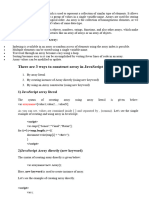Lab - 03 Literal Operators and Arrays
Uploaded by
Urooj Fatima ShaikhLab - 03 Literal Operators and Arrays
Uploaded by
Urooj Fatima ShaikhDEPARTMENT OF COMPUTER SCIENCE, SUKKUR IBA UNIVERSITY
Sukkur Institute of Business Administration University
Department of Computer Science
Object Oriented Programming using Java
BS – II (CS/AI/SE)
Spring-2024
Lab # 03: Java Essentials Lab: Exploring Literals, operators,
and Arrays
Instructor: Nimra Mughal
Objectives
After performing this lab, students will be able to understand:
• Use of literals
• Use of operators
• Arrays
a. One Dimensional
b. Multi-Dimensional
c. Jagged array
• Java Documentation basics
1 Object oriented programming, Spring-2024 Prepared By: Nimra Mughal
DEPARTMENT OF COMPUTER SCIENCE, SUKKUR IBA UNIVERSITY
Literals
In computer programming, a literal refers to the notation used to represent fixed values directly
in the source code of a program. Here's a brief explanation of literals for different types:
1. Integer literals: These represent whole numbers without any fractional or decimal
part. They can be expressed in decimal, binary, octal, or hexadecimal notation.
2. Floating-point literals: These represent numbers with a fractional part. They can be
written in standard decimal notation or in scientific notation (exponent form).
3. Character literals: These represent single characters enclosed within single quotes ('
'). They can also represent special characters using escape sequences (e.g., '\n' for
newline).
4. String literals: These represent sequences of characters enclosed within double quotes
(" "). Strings are used to represent text or sequences of characters.
5. Boolean literals: These represent the two boolean values: true and false. They are used
to represent logical values in boolean expressions.
6. Null literal: This represents the absence of a value or a reference to no object.
public class LiteralExample {
public static void main(String[] args) {
// Integer literals
int number = 10;
int binaryNumber = 0b1010;
int octalNumber = 012;
int hexNumber = 0xA;
// Floating-point literals
double doubleValue = 3.14;
float floatValue = 3.14f;
double exponentValue = 6.022e23; // Floating-point literal in exponent form
// Character literals
char character = 'A';
char unicodeChar = '\u0041';
// String literals
String str = "Hello, World!";
// Boolean literals
boolean boolTrue = true;
boolean boolFalse = false;
// Null literal
Object obj = null;
2 Object oriented programming, Spring-2024 Prepared By: Nimra Mughal
DEPARTMENT OF COMPUTER SCIENCE, SUKKUR IBA UNIVERSITY
// Printing the values
System.out.println("Integer literals:");
System.out.println("number: " + number);
System.out.println("binaryNumber: " + binaryNumber);
System.out.println("octalNumber: " + octalNumber);
System.out.println("hexNumber: " + hexNumber);
System.out.println("\nFloating-point literals:");
System.out.println("doubleValue: " + doubleValue);
System.out.println("floatValue: " + floatValue);
System.out.println("exponentValue: " + exponentValue);
System.out.println("\nCharacter literals:");
System.out.println("character: " + character);
System.out.println("unicodeChar: " + unicodeChar);
System.out.println("\nString literals:");
System.out.println("str: " + str);
System.out.println("\nBoolean literals:");
System.out.println("boolTrue: " + boolTrue);
System.out.println("boolFalse: " + boolFalse);
System.out.println("\nNull literal:");
System.out.println("obj: " + obj);
}
}
Arrays in java
Making an array in a Java program involves three distinct steps:
• Declare the array name.
• Create the array.
• Initialize the array values.
We refer to an array element by putting its index in square brackets after the array name.
To use an array in a program, you must declare a variable to reference the array and specify the
array’s element type.
Syntax:
elementType[] arrayRefVar;
3 Object oriented programming, Spring-2024 Prepared By: Nimra Mughal
DEPARTMENT OF COMPUTER SCIENCE, SUKKUR IBA UNIVERSITY
The elementType can be any data type, and all elements in the array will have the same data
type.
Say suppose :
int[] arrayRef;
Unlike declarations for primitive data type variables, the declaration of an array variable does
not allocate any space in memory for the array. It creates only a storage location for the
reference to an array.
If a variable does not contain a reference to an array, the value of the variable is null. You cannot
assign elements to an array unless it has already been created. After an array variable is
declared, you can create an array by using the new operator and assign its reference to the
variable with the following syntax:
arrayRefVar = new elementType[arraySize];
int[] arr; //integer array
arr = new int[10];
Java has a shorthand notation, known as the array initializer, which combines the declaration,
creation, and initialization of an array in one statement using the following syntax:
elementType[] arrayRefVar = {value0, value1, ..., valuek};
Arrays Class
Arrays class which is in java.util.Arrays package, is a provision by Java that provides you
a number of methods through which arrays can be manipulated. This class also lets you perform
sorting and searching operations on an array.
https://www.geeksforgeeks.org/array-class-in-java/
https://docs.oracle.com/javase/8/docs/api/java/util/Arrays.html
1D-Array Example
public class ArrayExample1D {
public static void main(String[] args) {
// Declaring and initializing an array of integers
int[] numbers = {1, 2, 3, 4, 5};
// Accessing elements of the array
int thirdNumber = numbers[2]; // Accessing the third element (index 2)
System.out.println("Third number is: " + thirdNumber);
// Iterating through the array
System.out.println("Elements of the array:");
for (int i = 0; i < numbers.length; i++) {
System.out.println("Element at index " + i + ": " + numbers[i]);
}
// Array of strings
String[] names = {"Alice", "Bob", "Charlie"};
4 Object oriented programming, Spring-2024 Prepared By: Nimra Mughal
DEPARTMENT OF COMPUTER SCIENCE, SUKKUR IBA UNIVERSITY
// Accessing elements of the array
String firstName = names[0];
System.out.println("First name: " + firstName);
}
}
2D-Array java
public class TwoDArrayExample {
public static void main(String[] args) {
// Declaring and initializing a 2D array
int[][] matrix = {
{1, 2, 3},
{4, 5, 6},
{7, 8, 9}
};
// Accessing elements of the 2D array
System.out.println("Element at row 3, column 1: " + matrix[2][0]);
// Iterating through the 2D array
System.out.println("Elements of the 2D array:");
for (int i = 0; i < matrix.length; i++) {
for (int j = 0; j < matrix[i].length; j++) {
System.out.print(matrix[i][j] + " ");
}
System.out.println(); // Move to the next line after printing each row
}
}
}
public class TwoDArrayExample {
public static void main(String[] args) {
// Declaring and initializing a 2D array
int[][] matrix = {
{1, 2, 3},
{4, 5, 6},
{7, 8, 9}
};
// Accessing elements of the 2D array using foreach loop
System.out.println("Accessing elements of the 2D array:");
for (int[] row : matrix) {
for (int element : row) {
System.out.print(element + " ");
}
5 Object oriented programming, Spring-2024 Prepared By: Nimra Mughal
DEPARTMENT OF COMPUTER SCIENCE, SUKKUR IBA UNIVERSITY
System.out.println(); // Move to the next line after printing each row
}
}
}
Jagged array (UnEven Array)
public class JaggedArrayExample {
public static void main(String[] args) {
// Declaring and initializing a jagged array
int[][] jaggedArray = {
{1, 2, 3},
{4, 5},
{6, 7, 8, 9}
};
// Accessing elements of the jagged array using foreach loop
System.out.println("Accessing elements of the jagged array:");
for (int[] innerArray : jaggedArray) {
for (int element : innerArray) {
System.out.print(element + " ");
}
System.out.println(); // Move to the next line after printing each row
}
}
}
Operators in Java
https://www.javatpoint.com/operators-in-java
https://docs.oracle.com/javase/tutorial/java/nutsandbolts/operators.html
public class Bitwise {
public static void main(String[] args) {
int a = 5; // binary: 0101
int b = 3; // binary: 0011
// Bitwise AND
int resultAnd = a & b; // result: 0001
System.out.println("Bitwise AND: " + resultAnd); // Output: 1
// Bitwise OR
int resultOr = a | b; // result: 0111
6 Object oriented programming, Spring-2024 Prepared By: Nimra Mughal
DEPARTMENT OF COMPUTER SCIENCE, SUKKUR IBA UNIVERSITY
System.out.println("Bitwise OR: " + resultOr); // Output: 7
// Bitwise XOR
int resultXor = a ^ b; // result: 0110
System.out.println("Bitwise XOR: " + resultXor); // Output: 6
// Bitwise NOT
int resultNotA = ~a; // result: 11111111111111111111111111111010 (2's
complement)
System.out.println("Bitwise NOT of a: " + resultNotA); // Output: -6
// Left Shift
int resultLeftShift = a << 2; // result: 10100
System.out.println("Left Shift of a: " + resultLeftShift); // Output: 20
// Right Shift
int resultRightShift = a >> 1; // result: 0001
System.out.println("Right Shift of a: " + resultRightShift); // Output: 2
// Unsigned Right Shift
int unsignedRightShift = -8 >>> 2; // result:
00111111111111111111111111111110
System.out.println("Unsigned Right Shift of -8: " +
unsignedRightShift); // Output: 1073741822
}
}
Java Comments
Single line Multi-ilne Documentation comment
//This is single line com /* /**
ment This is *
Multiline *We can use various tags
commet *or heading or author name
*/ *We can also use HTML tags
*
*/
7 Object oriented programming, Spring-2024 Prepared By: Nimra Mughal
DEPARTMENT OF COMPUTER SCIENCE, SUKKUR IBA UNIVERSITY
Java Documentation Comments
import java.io.*;
/**
* Add Two Numbers!
* The AddNum program implements an application that
* simply adds two given integer numbers and Prints
* the output on the screen.
* <p>
* <b>Note:</b> Giving proper comments in your program makes it more
* user friendly and it is assumed as a high quality code.
*
* @author Zara Ali
* @version 1.0
* @since 2014-03-31
*/
public class Account {
/**
* This is the main method which makes use of addNum method.
* @param args Unused.
* @exception IOException On input error.
* @see IOException
*/
public static void main(String args[]) throws IOException {
AddNum obj = new AddNum();
int sum = obj.addNum(10, 20);
System.out.println("Sum of 10 and 20 is :" + sum);
}
}
The javadoc tool recognizes the following tags:
https://www.tutorialspoint.com/java/java_documentation.htm
https://www.javatpoint.com/java-comments
8 Object oriented programming, Spring-2024 Prepared By: Nimra Mughal
DEPARTMENT OF COMPUTER SCIENCE, SUKKUR IBA UNIVERSITY
Exercises
1. Create two multi-dimensional(2d) arrays of size 4 by 4 and perform:
a. Matrix addition
b. Matrix Multiplication
c. Matrix subtraction
2. You're creating a program to manage student grades for a class. How would you use a
2D array to store corresponding grades of students for multiple assignments? Explain how
you would initialize the array, input grades, calculate averages for each student, and identify
students who need extra help.
3. You're tasked with creating a program to manage employee records for a company.
How would you use a 2D array to store information such as employee IDs, and salaries?
(Suppose the salaries are stores in the Integer type)
Explain how you would create and initialize the array, search for employees by ID, and
calculate statistics such as average salary. (please provide a java code)
a. Use Hexadecimal notation for emploee ids
4. Bit Manipulation:Write a Java program to count the number of set bits (bits with value 1)
in a given integer.
5. Check Power of Two: Write a Java program to check if a given integer is a power of two or
not. Use bitwise operators for the check.
9 Object oriented programming, Spring-2024 Prepared By: Nimra Mughal
DEPARTMENT OF COMPUTER SCIENCE, SUKKUR IBA UNIVERSITY
6. Detect Odd or Even without Modulo Operator: Create a Java program to determine
whether a given integer is odd or even without using the modulo (%) operator. Instead, use
bitwise operators.
7. Write code that creates an array named odds and stores all odd numbers between 1 and
30 into it using a for loop.
8. Calculate Hamming Distance: Write a Java a code to calculate the Hamming distance
between two integers. Hamming distance is the number of positions at which the
corresponding bits are different. Use bitwise operators to perform the calculation.
9. Create a program to calculate the amount of tax owed based on income and tax
brackets.
In this task, you will develop a program that computes the amount of tax owed by an
individual based on their income and a set of predefined tax brackets. program will
determine the tax owed by applying the appropriate tax rate to each portion of the income
within the corresponding tax bracket and then summing up these amounts.
For this exercise, we'll use the following standard tax brackets and rates:
a. Income up to $10,000: Tax rate of 10%
b. Income from $10,001 to $20,000: Tax rate of 15%
c. Income above $20,000: Tax rate of 20%
10. Create a class Person with fields for name, age, and address.
• Use @author and @version tags in the class comment.
• Use @param and @return tags in method comments.
• Format comments with HTML tags for emphasis and lists (e.g., <b>).
10 Object oriented programming, Spring-2024 Prepared By: Nimra Mughal
You might also like
- 182196-1739335271-Grade_VIII-_Study_Material-_Java_2No ratings yet182196-1739335271-Grade_VIII-_Study_Material-_Java_216 pages
- Pallavi OOPM Lab Manual (1) Final 1 To 9 2.3.4No ratings yetPallavi OOPM Lab Manual (1) Final 1 To 9 2.3.487 pages
- ENotes 1253 Content Document 20250117092736AMNo ratings yetENotes 1253 Content Document 20250117092736AM18 pages
- Uint-I(Array,String,Vector) (Autosaved)No ratings yetUint-I(Array,String,Vector) (Autosaved)23 pages
- Lab Session 2: Learning I/O Operations in Java Console. Exploring Java's Built in ClassesNo ratings yetLab Session 2: Learning I/O Operations in Java Console. Exploring Java's Built in Classes25 pages
- Chapter 7 - Iterative - Data Types - Part1No ratings yetChapter 7 - Iterative - Data Types - Part123 pages
- Numerical Methods in Engineering with MATLAB Jaan Kiusalaas all chapter instant download100% (4)Numerical Methods in Engineering with MATLAB Jaan Kiusalaas all chapter instant download61 pages
- A Brief Python Tutorial: Sven H. Chilton University of California - BerkeleyNo ratings yetA Brief Python Tutorial: Sven H. Chilton University of California - Berkeley44 pages
- AP Computer Science A 2019 Ced Scoring GuidelinesNo ratings yetAP Computer Science A 2019 Ced Scoring Guidelines10 pages
- Solidity Docs PTBR Readthedocs Io PT Latest (161 179)No ratings yetSolidity Docs PTBR Readthedocs Io PT Latest (161 179)19 pages
- C The Ultimate Beginners Guide To C Programming With Step by Step100% (1)C The Ultimate Beginners Guide To C Programming With Step by Step87 pages
- CS-114 Fundamentals of Programming UpdatedNo ratings yetCS-114 Fundamentals of Programming Updated173 pages
- Aveva Net Marine Gateway Administrator GuideNo ratings yetAveva Net Marine Gateway Administrator Guide72 pages
- Excel VBA Multidimensional Array For Assigning ValueNo ratings yetExcel VBA Multidimensional Array For Assigning Value54 pages
- 182196-1739335271-Grade_VIII-_Study_Material-_Java_2182196-1739335271-Grade_VIII-_Study_Material-_Java_2
- Lab Session 2: Learning I/O Operations in Java Console. Exploring Java's Built in ClassesLab Session 2: Learning I/O Operations in Java Console. Exploring Java's Built in Classes
- Numerical Methods in Engineering with MATLAB Jaan Kiusalaas all chapter instant downloadNumerical Methods in Engineering with MATLAB Jaan Kiusalaas all chapter instant download
- A Brief Python Tutorial: Sven H. Chilton University of California - BerkeleyA Brief Python Tutorial: Sven H. Chilton University of California - Berkeley
- Solidity Docs PTBR Readthedocs Io PT Latest (161 179)Solidity Docs PTBR Readthedocs Io PT Latest (161 179)
- C The Ultimate Beginners Guide To C Programming With Step by StepC The Ultimate Beginners Guide To C Programming With Step by Step
- Excel VBA Multidimensional Array For Assigning ValueExcel VBA Multidimensional Array For Assigning Value

























































































